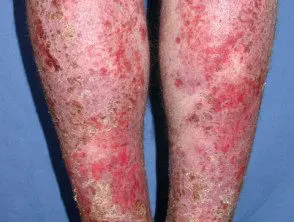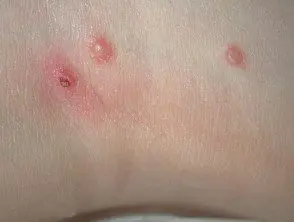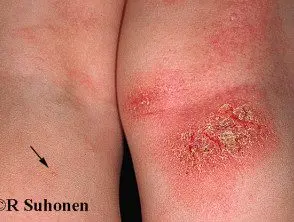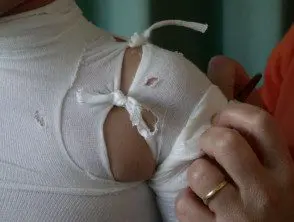Psychosocial effects of atopic dermatitis
None chronic the disease can have a major impact on the victim's life, and this is particularly true in childhood eczema, as well as about the lives of their families. Most people with eczema continue to lead normal lives, but for a few, eczema can be a source of significant psychosocial distress.
Young children often suffer from sleep disorders that are difficult for parents and can cause behavioral problems in the child. Older children may become shy and withdrawn due to the embarrassment of a visible skin condition. Activities such as sports, school camps, and swimming may need to be restricted, further distancing the child. Long absences from school can result from both eczema itself and the social avoidance that develops in some children.
Adults can also suffer shyness and withdrawal due to the appearance of eczema. The job can be difficult and some people with bad eczema will have to change jobs to cope with their eczema.
Delayed growth due to atopic dermatitis
Severe eczema can decrease the growth rate in children. This is most often due to eczema rather than its treatment. Corticosteroids, particularly oral corticosteroids, can also cause short-term growth retardation, so the use of these medications must be closely monitored.
Bacterial infections in atopic dermatitis
Bacterial skin infection It is extremely common in atopic dermatitis. This is usually with staphylococci or streptococci bacteria (See Staphylococcal skin infections and Streptococcal skin infections). The infection is due in part to breaks in the skin of very dry and divided skin and scratching of the itchy areas. People with atopic dermatitis also appear to have a reduced ability to fight these common skin bacteria. As a result, people with atopic dermatitis often also suffer from boils, folliculitis, and impetigo. This begins a vicious circle, as the infection makes the eczema worse and more resistant to the usual treatment with emollients and current steroids Antibiotics are often required to clear the infection before eczema can be subdued control.
Rarely, bacterial infection can be especially serious and involve a large part of the skin's surface. This can cause blood poisoning (septicemia) and require hospitalization. Babies are at particular risk for serious skin infections.
Staphylococcal infection in atopic dermatitis.

Infected dermatitis

Infected dermatitis

Infected dermatitis
Viral infections in atopic dermatitis.
Viral infections, particularly the herpes simplex virus (the virus that causes cold sores and genital herpes), are more common in patients with atopic dermatitis. A herpes simplex infection can spread quickly in the presence of eczema and cause a serious infection, known as herpetic eczema. This can be presented as a generalized disease with fever, discomfort and a extended scab, blisters eruption. It can also be more located, often confined to areas with active eczema. A history of a recent cold sore in the affected individual or close contact is helpful in making the diagnosis before swab results are available. Due to the severity of the condition, oral treatment antiviral Agents like acyclovir or valacyclovir are often started before results are available.
Coxsackium eczema is a atypical A form of foot-and-mouth disease that presents as blisters in areas of active atopic eczema.
Herpetic eczema

Herpetic eczema

Herpetic eczema

Herpetic eczema
Molluscum contagiosum is another common viral skin infection that most often affects children. It may be more common in people with atopic dermatitis. Molluscum infection often causes an increase in eczema symptoms, usually worse around mollusk-affected areas. Molluscum lesions often resolve more slowly in people with atopic dermatitis, and eczema may continue to be more active until the mollusc finally disappears. Resolution may be accelerated by mild trauma to one or two mollusc lesions at a time to generate a inflammatory reply. This can be done by quickly pinching with clean tweezers for one or two injuries each night for a few nights. This is generally better tolerated if done while the child is asleep.
Molluscum contagiosum

Molluscum contagiosum

Molluscum contagiosum

Molluscum contagiosum
Erythrodermic atopic dermatitis
Erythroderma It is a generalized reddening of the skin. It is a very serious skin condition that can be fatal. It is caused by a number of conditions including eczema, psoriasis, other inflammatory skin conditions, medications, and malignant tumors.
Erythrodermic eczema generally occurs in patients with worsening or unstable eczema. The treatment of erythroderma is similar despite the many underlying causes. Inpatient hospital treatment is generally required to cool the skin and support hydration and temperature control of the affected individual. Skin infection is also common in the context of erythrodermic eczema, and intravenous antibiotics are commonly administered over a period of time. Treatment for erythrodermic eczema may include:
- Hospitalization for supportive care, including IV fluids and temperature regulation.
- Mild emollients and refreshing wet dressings
- Bed rest
- Topical steroids
- Antibiotics
- Treatment of complications (eg, diuretics for inflammation, nutritional support for weight loss)
- Treatment with wet wraps, emollients, and topical steroids and bed rest produces a rapid improvement in most affected people. Early treatment leads to a better result.
Complications of erythroderma include:
- Dehydration
- Heart failure
- Infection
- Hypothermia
- Protein loss and malnutrition.
- Edema (swelling)
- Death.
Erythrodermic atopic dermatitis


Wet wraps

Wet wrap detail
Eye abnormalities associated with atopic dermatitis.
Many eye changes associated with atopic dermatitis can be seen.
A Dennie-Morgan fold is a fold of skin under the lower eyelid. Due to chronic eyelid dermatitis, it is often seen in atopic dermatitis, but it can also be seen independently from atopic dermatitis and is of no importance to the person's overall health.
Conjunctival irritation is also common. It may be due to a allergic reaction, such as hay fever, or a irritating reply.
Keratoconus (conical eyeball) is a rare condition that is occasionally associated with atopic dermatitis. It is due to the degeneration and weakening of the cornea (the front of the eye) resulting in pushing the front of the eye outward due to normal pressure inside the eyeball. It can cause marked visual disturbances and can be partially corrected with contact lenses. The onset of keratoconus is after childhood and the progression is usually self-limited.
waterfalls It can also occur in association with severe atopic dermatitis, generally around 15-25 years of age. They are almost always bilateral and may have a characteristic appearance on eye examination that helps distinguish them from other causes of waterfall.
Retinal detachment is when part of the inner lining of the eye is separated from the underlying structures. This is a very rare complication that is seen in association with atopic dermatitis.

